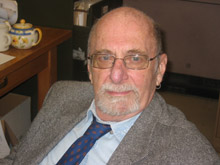
Curator's Professor of Physics
Founder (with Lon Wilkens), Center for Neurodynamics (1996)
mossf@umsl.edu
Tel: 314-516-6150
Fax: 314-516-6152
Curriculum Vitae (PDF Version)
Recent Research
Dr. Moss's recent research covers many applications of nonlinear dynamics and stochastic processes to biological systems. An expert in stochastic resonance, he and his colleagues were the first to demonstrate behavioral stochastic resonance in a behaving animal, the paddlefish. He has also studied the role of stochastic resonance in human perception, the role of nonlinear dynamics and synchronization in peripheral sensory systems of invertebrates.
Dr. Moss's most recent work involves experimental studies of swarming and optimal feeding strategies of zooplankton*, as well as modeling and simulations of these phenomena.
Experiments with several species of the zooplankton, Daphnia, while foraging for food, are in progress. They move in sequences: hop-pause-turn-hop etc. While we have recorded hop lengths, hop times, pause times and turning angles, our current focus is on histograms representing the distributions of the turning angles. We find that different species, including adults and juveniles, move with similar turning angle distributions that can be accurately described with exponential functions. Random walk simulations and a theory based on active Brownian particles, by the applied stochastics group at Humboldt University in Berlin, Germany, indicate a maximum in food gathering efficiency at an optimal width of the turning angle distribution. That is, an optimal noise intensity leads to maximum foraging success, an effect we call Natural Stochastic Resonance. Foraging takes place within a fixed size food patch during a fixed time. We hypothesize that the exponential distributions and the narrow range of widths observed in wild Daphnia were selected for survival over evolutionary time scales.
Collaborations:
Prof. Lutz Schimansky-Geier and colleagues, Laboratory for Applied Stochastic Processes, Institute of Physics, Humboldt University in Berlin, Germany.
Prof. J. Rudi Strickler and colleagues, Great Lakes WATER Institute, University of Wisconsin at Milwaukee, Wisconsin, USA.
*The movie "Into the Daphnia vortex." appeared in Chaos. 14(4):S10, 2004.
